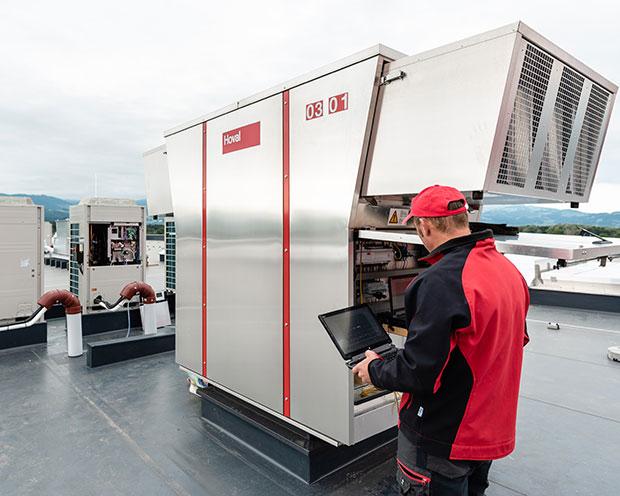Operators of high-ceilinged shed-type buildings need to maintain comfort levels with optimum efficiency and flexibility, says Ian Dagley General Manager of Hoval Ltd.
 When it comes to maintaining good indoor air quality (IAQ) and thermal comfort, with optimum energy efficiency, ‘shed’ type properties require a flexible approach that accommodates several key criteria. Whether they be for manufacturing, logistics, retail or leisure activities, the high ceilings and high air volumes of such buildings pose a number of challenges.
When it comes to maintaining good indoor air quality (IAQ) and thermal comfort, with optimum energy efficiency, ‘shed’ type properties require a flexible approach that accommodates several key criteria. Whether they be for manufacturing, logistics, retail or leisure activities, the high ceilings and high air volumes of such buildings pose a number of challenges.
In addition to delivering the required performance and efficiency, there is also the question of how the space is being used – and how that may change in the future. For example, many such buildings often change layouts and many warehouses have areas that are only used sporadically. This means that ventilation requirements may change with time as layout and usage change and it can prove expensive if the heating and ventilation systems need to be modified each time this happens.
Thus, the design of these systems needs to include some inherent adaptability. Plus, increasingly, building owners and operators are also looking for energy savings through the use of low carbon technologies such as air source heat pumps.
There are various design options, including centralised air handling plants serving a network of ducts and diffusers, decentralised ventilation units operating independently of each other or an integrated system that combines several units, each configured to the space it is serving. The latter option typically proves to be the most flexible.
Centralised systems tend to lack adaptability without considerable re-configuration of ductwork and diffuser locations, disrupting activities and adding to cost. In contrast, decentralised ventilation systems, or ‘hybrid’ systems that combine the characteristics of both centralised and decentralised systems, are increasingly popular because of their versatility.
Decentralised systems
Unlike central air handling units, decentralised systems normally work without supply and extract ductwork. This makes design easier and reduces installation costs. Installation is simple, using pre-wired units that are easy to change at a later date. When used for heating as well as ventilation, it is possible to incorporate an air source heat pump to provide some or all of the space heating – or to pre-heat a process in a manufacturing application.
With decentralised ventilation systems it is easy to provide each space – or each zone within a large space – with its own ventilation unit, controlled independently of units in other spaces/zones to address different activities, variable occupancy patterns and changes in usage. The ability to adjust ventilation rates to the actual demand within each space (demand-controlled ventilation) minimises running costs without compromising on comfort.
The latest designs of decentralised ventilation units also incorporate air injectors that distribute supply air at different temperatures to avoid draughts and ensure that the ventilation for each space within the building is optimised. The air distribution pattern can be changed automatically and is infinitely variably between vertical and horizontal, thereby delivering the desired adaptability mentioned earlier. Also, the air injectors give very effective air distribution, allowing a lower air volume to be used, resulting in a further reduction in investment.
Air injectors also minimise thermal stratification, which can be very wasteful in high-ceilinged buildings. Well-designed vortex air distributors enable easy adjustment of the air stream range from 4m to 25m and regulate the scatter angle (induction) of the air stream as a function of the mounting height. Temperature stratification is thereby limited to 0.15 Kelvin per mounting height metre (K/m) – compared with up to 1.0 K/m in conventional centralised systems.
Additionally, this decentralised ‘island solutions’ approach ensures that there is no contamination of one zone by another, which can be an issue with central plant serving ductwork distribution. For large installations this also facilitates phased investment to spread the capital costs.
Lifecycle costs are also an issue and one key element in lowering running costs is heat recovery, where much of the heat energy in the extract air is recovered and transferred to the incoming supply air via a plate or rotary heat exchanger. In such cases, it is important that the system works automatically and is ‘user-friendly’.
We have seen paybacks as low as two years for these kinds of installation, due to lower running costs – which then contribute to increased profits through the remaining life of the plant.
A system approach
A ‘system’ approach is based on a three-module concept, comprising a heat source (e.g. condensing boiler, heat pump), ventilation units providing recirculation or air changes, and a control system. If heat pumps are used instead of gas boilers, then decentralised units can be combined with reverse cycle air source heat pumps to provide heating or cooling. In some projects it may also be useful to interlink with existing heating or cooling solutions from different manufacturers.
The system approach may also include zone control which, in conjunction with temperature- and time-based zone control, can optimally adapt the heating times and space temperatures to logistical and energy-related requirements.
In all cases, it is particularly important to take account of installation and maintenance factors at the design stage of the project. This is another reason for the growing popularity of roof-mounted decentralised units, as they offer several advantages in this respect. The fact that they are installed at high level, or on the roof, means that installation has minimal impact on the activities below and the units are easily accessible from the roof for servicing and filter replacement. A further benefit is that they do not occupy any valuable floor space.
Summary
The different uses and requirements of shed type buildings are most easily met with a system based on decentralised units, operating on a standalone basis or as part of an integrated system. The adaptability of this approach not only makes it straightforward to meet current requirements but also helps the building to adapt to changing usage in the future.
Hoval
t: 01636 672 711




Comments are closed.